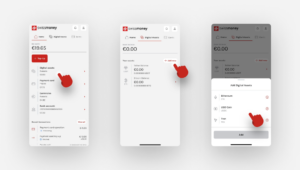To exchange Crypto for Fiat, you must first sell your crypto assets. You can do this using a preferred exchange method. Once you have completed an exchange, you can withdraw the fiat money to a linked bank account.
In this article, we’ll explore nine ways to convert cryptocurrency to fiat, discussing their benefits and fees. Additionally, we’ll include a list of platforms currently offering this service.
[key_takeaways title="Quick Answer: to convert crypto to fiat, you can follow these steps:"]
- Step 1: Choose a trusted crypto exchange that supports your coin.
- Step 2: Sign up for an account and verify your identity (if required).
- Step 3: Transfer your crypto from your wallet to the exchange's deposit address.
- Step 4: Place a sell order, choosing market price (sell instantly) or limit price (set your desired price).
- Step 5: Once your order fills, you'll receive fiat currency (USD, EUR, etc.) in your exchange account.
- Step 6: Withdraw the fiat currency to your linked bank account.
[/key_takeaways]
What are the most popular methods to convert crypto to fiat?
There are many various options for how you can transfer crypto to fiat currency. Here are the most popular ones:
Option 1: Crypto exchanges
A crypto exchange is a platform for buying, selling and trading cryptocurrencies. Centralized exchanges serve as marketplaces where users can conduct financial transactions involving digital assets.
According to scientists, cryptocurrencies are traded on more than 300 exchanges worldwide. The prices for the same cryptocurrency can vary by up to USD 1000.
Pros:
- A wide range of cryptocurrencies for portfolio diversification.
- High liquidity and trading volume, minimizing price slippage during transactions.
- User-friendly interfaces and mobile apps facilitate easy buying, selling, and trading of cryptocurrencies.
- Security measures like two-factor authentication, cold storage, firewalls, and intrusion detection systems.
- Various trading tools, including charting, technical indicators, and news feeds.
Cons:
- Changing regulations pose uncertainties, impacting operations.
- Possible technical issues like outages or glitches.
- Occasionaly high fees and long transfer times for deposits and withdrawals.
Risks
First, exchanges are alluring targets for hackers. A successful attack can result in the loss of user funds.
Additionally, fraudsters use different methods to extort money. Such scams can take the form of phishing attacks or pyramid schemes.
Also, some platforms manipulate the price, misleading investors in market transactions.
Transfer time
The transfer time for cryptocurrency exchanges varies depending on the exchange and the type of cryptocurrency. In general, it takes from a few minutes to an hour.
Fees and pricing
Trading fees: 0-1.49%
Withdrawal fees: Varies, depending on the cryptocurrency and the exchange
Deposit fees: Usually free or low
A list of reputable cryptocurrency exchanges:
- Binance
- Coinbase
- Kraken
- Bitfinex
- Gemini
- Huobi
- KuCoin
- Crypto.com
- eToro
- BYDFi
Step-by-step guide: How to exchange crypto to fiat on a crypto exchange:
Step 1: Pick a reliable exchange that accepts your preferred currencies.
Step 2: Sign up on the exchange’s website with your name, email, and password.
Step 3: Verify your identity by submitting the required documents.
Step 4: Enhance security by using two-factor authentication.
Step 5: Deposit funds into your account through your chosen payment method.
Step 6: Select the cryptocurrency you want to buy.
Step 7: Decide the amount to purchase and place the order.
Read More:
📚Best Crypto Exchanges in Germany
📚Best Crypto Exchanges in Europe
📚Best Crypto Exchanges for Day Trading
Option 2: Peer-to-peer exchanges
Peer-to-peer (P2P) platforms let buyers and sellers trade cryptocurrencies directly without relying on a centralized intermediary.
These platforms provide enhanced privacy compared to conventional online transactions. They allow users to trade various cryptocurrencies using their preferred payment methods.
P2P exchanges can be useful for trading illiquid or high-value assets and circumventing the fees.
Pros:
- Lower transaction fees and currency conversion rates.
- Users have more control and independence.
- Less vulnerable to censorship and manipulation.
- Increased liquidity for specific cryptocurrencies.
- Enhanced privacy and security with encryption and fraud prevention measures
- Faster – instant credit card transactions and relatively swift bank transfers.
- Regulatory compliance with local restrictions independently of traditional intermediaries.
Cons:
- Transactions can be complex, involving pre-agreed terms.
- Slow trading speeds.
- Vague support for specific cryptocurrencies.
- Limited customer support means users have to troubleshoot independently.
Risks
When it comes to P2P exchanges, there is a risk of fraud risk. It rises when users directly interact without third-party verification, making transactions complex with agreed terms.
Counterparty risk is yet another crucial issue. Users may face non-compliance due to insufficient funds or malicious intent.
Transfer time
P2P transfer time varies depending on the exchange and payment method. However, usually, the P2P transfer takes 1-6 hours.
Fees and pricing
Maker fee: 0.0-1.0%
Taker fee: 0.1-5.0%
Payment method fees: 0.0-5.0%
A list of reputable cryptocurrency P2P exchanges:
- LocalBitcoins
- Binance P2P
- Paxful
- Remitano
- HodlHodl
- LocalCryptos
- OpenBazaar
- Wall of Coins
- AgoraDesk
- OpenPeer
Step-by-step guide: How to exchange crypto to fiat on a P2P exchange:
Step 1: Sign up and verify your account on a P2P exchange platform.
Step 2: Deposit cryptocurrency into the exchange using your wallet address or QR code.
Step 3: Complete identity verification as the exchange requires it for compliance and security.
Step 4: Place a sell order, specifying the amount and desired price.
Step 5: Confirm the transaction for processing.
Step 6: After completing the transaction, receive the equivalent amount in traditional fiat currency, transferable to your bank account.
Be aware of potential fees by checking the exchange’s fee structure.
Option 3: Crypto on-ramps and off-ramps
In crypto, on-ramps are services or platforms that let users make a fiat-to-crypto exchange. Usually, you can buy crypto through a bank transfer and credit or debit card.
Conversely, an off-ramp is a service or platform allowing users to convert digital assets into cryptocurrencies. They help convert cryptocurrency profits into cash or can be used for purchasing goods and services in regular currency.
Pros:
- Simpler cryptocurrency trading with regular money.
- A user-friendly experience and easy access to the crypto market.
- Advanced measures such as two-factor authentication and encryption to protect users’ funds.
- High liquidity.
Cons:
- Varying charges.
- Time-consuming identity verification processes involving the provision of personal information.
- The lack of regulation in numerous jurisdictions can heighten the vulnerability to fraud and scams.
Risks
Moreover, the off-ramps sometimes become a tool for cashing out stolen Bitcoin. Fraudsters use them to exchange funds stolen from during the breach on an exchange.
Transfer time
On-ramp transfer time depends on the payment method you choose. Bank transfers usually take 1 to 5 business days, while using credit or debit cards can result in a transfer time of 1 to 3 business days.
The fastest way to transfer money from off-ramps is by using cryptocurrency wallets. It’ll take up to 3 hours. If you choose a bank transfer or payment processor, you may need to wait up to 5 days.
Fees and pricing
Maker fees: 0-0.5%
Taker fees: 0.5- 4%
Payment processing fees: 2-5%
A list of reputable cryptocurrencies on and off-ramps:
- swissmoney
- Coinbase
- Binance
- Kraken
- Gemini
Step-by-step guide: How to exchange crypto to fiat on a ramp:
Step 1: Select a reputable on and off-ramp platform.
Step 2: Set up and verify your account.
Step 3: Deposit or transfer crypto to the platform.
Step 4: Execute the trade to sell crypto to fiat (off-ramp).
Step 5: Choose your preferred payment method.
Step 6: Finalize the transaction and ensure the platform transfers the funds to the destination.
📚Related: How to Choose Crypto On and Off-Ramp Platform
Option 4: Crypto ATMs
Crypto ATMs, also called Bitcoin ATMs or BTMs, are physical machines that enable users to buy and sell cryptocurrencies using regular money. They function similarly to traditional ATMs but for digital assets.
Users deposit cash, and choose the cryptocurrency they want, and the ATM dispenses the corresponding amount.
For withdrawals, users insert cryptocurrency, and select the desired fiat amount, and the ATM dispenses the equivalent cash after verifying ownership.
Pros:
- A convenient and accessible way to buy and sell cryptocurrencies.
- No need for a digital wallet or online account.
- 24/7 availability.
Cons:
- Higher fees.
- A limited selection of cryptocurrencies.
- Crypto ATM transactions may be delayed or fail due to network congestion on the blockchain.
Risks
First, ATMs can be altered to steal cryptocurrency or personal information from users. Furthermore, some ATMs offer anonymous transactions. It can increase the risk of unauthorized money withdrawals.
Transfer time
Some cryptocurrencies have faster transaction times than others. However, crypto ATM transaction takes from 10 to 60 minutes.
Fees and pricing
Transaction fees usually range from 5% to 10% of the amount.
A list of reputable crypto ATMs:
- CoinFlip
- General Bytes
- Bitcoin Depot
- BitAccess
- RockItCoin
- Coin Cloud
- Bitstop
- Athena Bitcoin
- Byte Federal, Inc.
- CoinSource
Step-by-step guide: How to exchange crypto to fiat at crypto ATM:
Step 1: Locate a crypto ATM.
Step 2: Undergo a verification process.
Step 3: Select the sell option.
Step 4: Determine the amount of Bitcoin you want to buy or sell.
Step 5: Confirm the transaction and follow the provided steps.
📚Read! Bitcoin ATM withdrawal: A Complete Guide
📚Related: Withdraw Money From the ATM
Option 5: Crypto debit cards
A crypto debit card is a prepaid card that lets you spend your crypto, whether shopping online or in-store. The card is linked to a crypto wallet or crypto debit card account, allowing one to access the balance.
The crypto debit card automatically converts crypto into fiat currency during the transaction.
Pros:
- Simple usage like any other Visa or Mastercard.
- Eliminates the need to convert it to fiat currency beforehand.
- Enhanced transaction privacy.
- Lower fees compared to traditional cryptocurrency exchanges.
- Cashback.
Cons:
- A limited number of cryptocurrencies.
- A third-party provider holds crypto.
- Currency conversion fees.
Risks
Crypto debit cards come with risks as they connect to your cryptocurrency wallet. It can expose your digital assets if the card is lost or stolen. Also, they may be more susceptible to hacking and fraud than traditional debit cards.
Users of crypto debit cards often face scams, such as phishing attacks and malware, putting the security of their cryptocurrency at risk.
Lastly, the legal and regulatory crypto landscape is still evolving. This process makes it challenging for crypto debit card users to grasp their rights and protections.
Transaction time
Usually, the crypto debit card payments are processed immediately.
Fees and pricing
Conversion fee: 0.5-5%.
Foreign transaction fee: up to 3%.
Loading fee: 0.5-5%
ATM withdrawal fee: $1-5 per transaction
Monthly maintenance fee: $5-15
Inactivity fee: $5-10
Note that these are just possible fees. Card providers may not charge some of them.
A list of reputable crypto debit cards
- swissmoney prepaid card
- Coinbase Crypto Card
- Crypto.com Visa Card
- Binance Card
- Wirex Visa Card
- BitPay Crypto Debit Card
- BlockCard
- Uphold Card
- Monolith
- BlockFi
Step-by-step guide: How to use crypto debit cars:
Step 1: Load the card with your preferred cryptocurrency using a linked crypto wallet app.
Step 2: Use the card like any other debit card – in-person, online, or at an ATM.
📚Read More: Best Crypto Credit and Debit Cards
📚Related: How to Buy Crypto With a Prepaid Card
Option 6: Crypto Brokers
A cryptocurrency broker can be a platform, business, or individual, allowing you to trade cryptocurrencies with fiat currency such as USD or EUR. It acts as a go-between for buyers and sellers.
People can create accounts with an online broker, enabling them to trade contracts for difference (CFD) on various assets like stocks and cryptocurrencies.
Pros:
- Easy-to-use interface.
- A better choice for new crypto traders.
- Faster transaction processing.
- Round-the-clock customer support.
- More security for your funds
- Governed in every jurisdiction and are under the control of financial authorities
Cons:
- A more limited selection of cryptocurrencies.
- Less control.
- Limited trading tools.
- Higher fees.
Risks
Unfortunately, there have been incidents when cryptocurrency brokers have been hacked or involved in fraud. This highlights the importance of choosing a reputable broker and being vigilant about risks.
Moreover, transparency varies among brokers. Not every fully discloses fees or trading practices, making it challenging to compare and decide.
Transfer time
Cryptocurrency brokers typically have varying transfer times. However, typically it takes around 4-6 days.
Fees and pricing
Spread: 0.2-2.0%
Commission: 0.5-3.0%
Margin fee: 0.1-5.0%
Inactivity fee: $0-10 per month
Withdrawal fee: 0.0005-0.001 BTC
A list of reputable crypto brokers
- Interactive Brokers
- Webull
- SoFi Invest
- TradeStation
- Alpaca Trading
- Plus500
- IG
- AvaTrade
- Capital.com
- Pepperstone
Step-by-step guide: How to exchange digital assets at crypto brokers:
Step 1: Register on the crypto broker’s website and verify your identity.
Step 2: Deposit funds into your account.
Step 3: Select the digital assets you want to trade from the available trading pairs.
Step 4: Place an order, specifying sell and the amount of cryptocurrency to trade.
Step 5: Your order is queued for execution, and the execution price depends on market conditions.
Step 6: Withdraw your cryptocurrency into your wallet.

Option 7: OTC trading
Over-the-counter, known as off-exchange or pink sheet trading, is a type of cryptocurrency trading that takes place off-exchange. In this scenario, the trade bypasses public exchanges and occurs directly between two parties.
Pros:
- A level of privacy and discretion.
- Enables large orders without disrupting the market.
- Access to a wider range of liquidity.
- Trades can be customized.
Cons:
- Higher fees.
- Less transparent than exchange-based trades.
Risks
Fraud risks are higher in OTC trading compared to exchange-based trading. The lack of a central authority overseeing transactions causes it.
Transfer time
The average transfer time for OTC trading is 1-2 days.
Fees and pricing
Trade execution fee: 0.5-2.0%
Order placement fee: 0.1-0.3%
Mark-up or mark-down: 0.1-1.0%
A list of reputable OTC trading platforms
- Fidelity OTC
- Kraken OTC Desk
- TD Ameritrade
- StoneX
- KuCoin
Step-by-step guide: How to use OTC trading platforms:
Step 1: Place a request on a crypto OTC trading platform. Specify the desired cryptocurrency and the amount for selling.
Step 2: Respond to market traders who provide conditions.
Step 3: Choose to accept or decline the deal. Finalize trade terms.
Step 4: Once terms are agreed upon, execute the trade.
Option 8: Decentralized exchanges (DEXs)
DEXs are decentralized exchanges on the blockchain, enabling crypto trading without a central authority or intermediaries. They use automated market makers (AMMs) or order books to match trades, with users holding funds in smart contracts.
Pros:
- Secure and private.
- No need to transfer their assets to a third party.
- Uncensored and resistant to government interference.
- Becoming increasingly liquid.
Cons:
- It is more complex to use.
- Lower market depth than centralized exchanges.
- Lack of customer support.
- Slow and expensive to use.
Risks
DEXs face risks as potential bugs or exploits in smart contracts could allow hackers to steal funds or manipulate the exchange. Also, lower liquidity on DEXs often results in reduced trading activity, wider spreads, and higher costs.
Some DEXs use centralized intermediaries, exposing users to fraud risks. Despite security efforts, DEXs can be vulnerable to attacks. Thus, users must safeguard their private keys to prevent loss or theft.
Transfer time
Usually, it takes from 1 to 10 minutes to finish the exchange.
Fees and pricing
Gas fee: $0-100
Swap fee: 0.025-0.5%
Liquidity fee: 0.25-0.75%
A list of reputable DEXs
- Uniswap
- SushiSwap
- Curve
- Balancer
- PancakeSwap
Step-by-step guide: How to use DEXs:
Step 1: Pick a reliable DEX and get a wallet for DEX interactions.
Step 2: Connect your wallet to the DEX on its site.
Step 3: Add funds to your wallet.
Step 4: Find the trading pair (e.g., ETH/USD) for the cryptocurrencies you want to trade.
Step 5: Enter the trade amount and define the maximum acceptable slippage (e.g., 0.5%) to align with expected prices.
Step 6: Review trade details and click Swap to submit your trade.
Step 7: Confirm the transaction, then wait for the confirmation and the funds to reach your wallet.
📚Read More: Centralized vs Decentralized Crypto Exchanges
Option 9: Crypto converters
Crypto converters, as tools, enable users to convert one cryptocurrency to another or fiat currency. These platforms typically operate in a centralized manner. Moreover, crypto converters necessitate users to hold their funds on the platform.
Pros:
- Easy to convert between different cryptocurrencies.
- Wide range of cryptocurrencies.
- Real-time exchange rates.
Cons:
- Less accurate.
- May charge fees for using their service.
- Not suitable for advanced trading.
Risks
Crypto converters, with potentially weaker security measures, can expose users to a higher risk of theft or loss in case of a hack. Moreover, the absence of financial regulation leaves investors open to scams.
Transfer time
Crypto converters operate fast. The transaction speed ranges from a few seconds to minutes.
Fees and pricing
various platforms have different ways of calculating the transaction fee. Some charge a percentage of the transaction value. It varies from 0.5% to 1%. Others have a fixed $1-5 fee per transaction.
Also, there is a maker-taker fee structure. Typically, the fee for makers is 0.5% and for takers – 1%.
A list of reputable DEXs
- Binance
- Crypto.com
- CoinMarketCap
- EXMO
- ChangeNOW
Step-by-step guide: How to use crypto converters:
Step 1: Select a crypto converter.
Step 2: Input the currencies and the amount you wish to convert.
Step 3: Calculate the exchange rate and examine associated fees.
Step 4: Confirm the conversion.
Step 5: After the conversion is finalized, withdraw the converted cryptocurrency to your wallet.
How to exchange crypto for fiat on swissmoney app
Exchanging crypto for fiat on the swissmoney app is straightforward. The app allows you to sell crypto for any available currency or spend it directly using a prepaid card.
Here’s how to exchange your crypto for fiat currency on the swissmoney app:
1. Open the swissmoney app and go to ‘Digital assets’.

2. Select the wallet of the currency you want to exchange. If you don’t have the needed wallet, tap ‘Add new’ and choose it from the provided currencies.

3. Tap the arrow symbol [→] and select ‘Sell’.

4. Choose between ‘Limit’ or ‘Market’ to decide how you want to sell your crypto assets.

If you select ‘Limit’, set the minimum price at which you’re willing to sell your crypto. If you opt for ‘Market’, you’ll sell your crypto immediately at the current market price.
5. Specify the amount of crypto you want to sell. You can enter the amount in either fiat or cryptocurrency.

If necessary, enter the minimum price. Review everything carefully and confirm the transaction by clicking ‘Sell’.
The funds will be added to your fiat wallet almost instantly.
Importance of understanding the various methods for converting crypto to fiat
At first sight, it may look easy to choose a method to exchange crypto for fiat. However, the abundance of options can be overwhelming.
There are a few factors as to why it is crucial to understand the various methods for converting crypto to fiat:
- To find the most effective method for you. Choose the form of converting crypto to fiat based on factors like amount, speed and fees. Concentrate on your needs and capacities to find the best place to exchange currency.
- To minimize fees. Fees for converting crypto to fiat vary widely. Knowing the fees for each option helps you avoid unnecessary expenses.
- To protect your assets: Certain conversion methods provide better security. Understanding security risks helps you choose based on your risk tolerance.
- To comply with regulations: Cryptocurrency regulations change. Understanding rules for converting crypto to fiat ensures compliance and prevents legal issues.
What’s the difference between a crypto exchange and a crypto wallet?
The crypto exchange is a platform that facilitates the buying, selling, and trading of cryptocurrencies. Crypto exchanges usually provide various trading pairs, enabling users to trade between cryptocurrencies or fiat currencies.
On the other hand, a crypto wallet is a place where you store your crypto. It does not necessarily come with a conversion feature. Sometimes, there is a Crypto Trading Desk incorporated into the wallet. There, users can make the currency conversion.
Related:
📚Best Custodial Wallets for Crypto
Wrapping up: the usual step-by-step process of how to convert crypto into fiat
Step 1: Get a cryptocurrency wallet.
Step 2: Choose a conversion method.
Step 3: Deposit your cryptocurrency into your chosen platform.
Step 4: Place a conversion order. Specify the amount of cryptocurrency you want to sell and the fiat currency to receive.
Step 5: Complete the conversion.
Step 6:Withdraw fiat money to your bank account.
How swissmoney can help
swissmoney, a comprehensive financial services provider, offers an all-in-one solution suitable for beginners and crypto enthusiasts. Users can efficiently manage funds in multiple currencies and maintain several crypto wallets.
Moreover, the platform simplifies exchanging and withdrawing crypto and enables fast transactions. With just a few taps on your phone, you can convert your crypto assets into fiat money.
In addition, swissmoney offers the convenience of a prepaid card. It allows users not only to buy or sell crypto but also to spend it daily.
Get the best of the crypto world with swissmoney.
FAQs
What is crypto to fiat exchange?
Crypto to fiat exchange converts digital assets into traditional currencies like USD, EUR, and GBP. To make an exchange, you have to sell your crypto assets.
When should I exchange crypto for fiat?
There are a few cases when you should exchange crypto for fiat. You can do it:
- After making significant profits from trading
- During market volatility to prevent potential losses
- For purchases where cryptocurrency is not accepted
- During tax preparation for calculating capital gains
- To reduce exposure to risks if you’re concerned about the long-term stability of the crypto market
What are the most popular fiat currencies to convert crypto to?
The most popular fiat currencies to convert crypto to are the US dollar (USD), the Euro (EUR), the British pound (GBP), and the Japanese yen (JPY).
What are the easiest ways of converting crypto into fiat?
The easiest ways of converting cryptocurrencies into fiat are at crypto-to-fiat exchanges, peer-to-peer (P2P) marketplaces or crypto converters.
What are the safest ways of converting crypto into fiat?
The safest way of converting crypto into fiat is by using reputable crypto-to-fiat exchanges or peer-to-peer (P2P) marketplaces.
What is Fiat currency?
Fiat currency or fiat money is a government-issued currency without physical backing. It means that it lacks intrinsic value. The worth of fiat currency is determined by the public’s trust in the issuing government.
What is Crypto?
Crypto, short for cryptocurrency, is a digital or virtual currency that uses cryptography for security. Furthermore, cryptocurrencies are decentralized. It means they are not subject to government or financial institution control.
Related:
- How to Transfer Crypto to Bank Account
- How to Withdraw Money from a Frozen Account
- How to Withdraw from Crypto.com
- How to Withdraw From Trust Wallet
- How to Cash Out on Coinbase
- From Crypto to Cash: How to Withdraw from Binance
- Crypto Wallet vs. Exchange: Which Suits Your Cryptocurrency Strategy
- How to Off-Ramp Crypto


